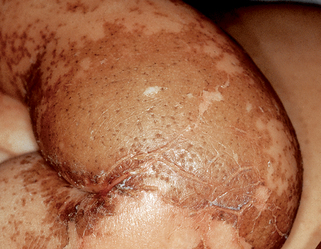Chapter 40 Cutaneous signs of nutritional disturbances
1. When do skin abnormalities occur in association with nutritional disturbances?
Skin manifestations occur when structural or enzymatic processes are affected by a deficiency or excess of a particular nutrient. This can be seen with dietary insufficiency or excess, malabsorption, drug interference, catabolic states, and metabolic, renal, hepatic, and inherited disorders. Nutrients include protein, carbohydrate, fat, vitamins, minerals, and trace elements.
2. Do nutritional disturbances involve the skin exclusively?
Absolutely not. Nutritional disorders are generalized conditions that cause multisystem disorders. Inadequate diet usually causes multiple nutrient deficiencies, with the resulting clinical picture a combination of these deficiencies. Clinical history, review of systems, and physical examination are of utmost importance when attempting to determine the underlying etiology of skin findings suggestive of a nutritional disorder.
3. Which skin changes are seen with protein and calorie deprivation in adults?
In clinical observations and prospective experiments, adults with starvation demonstrate rough, inelastic, pallid, gray skin with pigmentary changes in the malar and periorificial areas. Hair is thinned and growth of nails is slow. Nails may also demonstrate fissuring. There is decreased subcutaneous fat and, with time, muscle wasting.
4. What is marasmus?
Marasmus (from the Greek meaning wasting), or childhood caloric malnutrition, is a combined or proportional energy and protein deficiency with resultant catabolism and utilization of muscle and fat. There are no specific or significant skin findings. Infants often demonstrate a “monkey facies” due to loss of buccal fat that normally gives the face a rounded appearance.
Oumeish OY, Oumiesh I: Nutritional skin problems in children, Clin Dermatol 21:260–263, 2003.
5. What is kwashiorkor?
Kwashiorkor (from the Ga language of Ghana, meaning “sickness of the weanling”), or childhood protein malnutrition, is a result of protein deficiency with concurrent normal to excessive carbohydrate intake. It is a common affliction worldwide, and is seen in developed countries in association with poverty, neurologic disease, and malabsorption. There is muscle wasting with preservation of normal fat stores. The low ratio of protein to energy is felt to disrupt the body’s usual hypometabolic response to caloric deficiency and is biochemically manifest as markedly increased lipid peroxidation. Clinically, edema, hypoalbuminemia, growth retardation, fatty liver, psychomotor changes, and prominent skin findings are seen.
6. Describe the skin findings in kwashiorkor.
In black children, initial circumoral pallor progresses to diffuse depigmentation. In white children, there is diffuse blanching erythema that rapidly progresses to dusky nonblanching purple macules and papules. Classic findings include mosaic skin (dry, fine areas of desquamation with cracking along skin lines) and enamel paint dermatosis (Fig. 40-1), which evolves into large areas of erosion and desquamation. Hair in affected patients is sparse, thin, fragile, and depigmented. This hair depigmentation may produce the flag sign, which is alternating pigmented and depigmented bands seen along the hair shafts corresponding to periods of normal and inadequate nutrition.
8. Do skin abnormalities occur with fat deficiency?
Essential fatty acid deficiency occurs with deficiency of linoleic acid, a precursor of arachidonic acid. It is seen primarily with malabsorption syndromes and with prolonged total parenteral nutrition. Skin findings consist of a periorificial or generalized dermatitis caused by increased transepidermal water loss due to loss of the barrier function of the skin. Periorificial dermatitis cannot be clinically differentiated from lesions seen in acrodermatitis enteropathica (see question 18). Dietary or intravenous linoleic acid supplementation is curative, although adults often respond to only topical application.
9. Are any skin findings associated with fat excess?
Yes. Obesity researchers have documented an increased incidence of plantar hyperkeratosis (thickened soles), acanthosis nigricans, striae, and skin tags in patients overweight by more than 100%. Excess fat deposition predisposes to intertrigo, a dermatitis occurring between skinfolds, sometimes associated with secondary bacterial or candidal infection.
Stay updated, free articles. Join our Telegram channel

Full access? Get Clinical Tree









